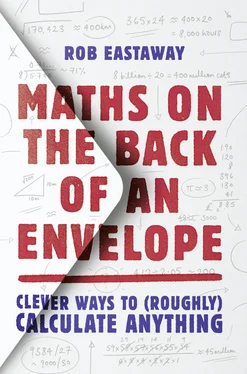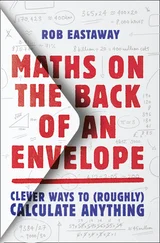Once a statistic like this is out there, published in a newspaper, quoted on a website, it becomes ‘fact’, and it can be re-quoted so often that the source may go unquestioned and very quickly be forgotten altogether.
It’s an important reminder that the majority of statistics published anywhere are estimates, many of them worked out on the equivalent of the back of an envelope. When back-of-envelope calculations produce a very different answer from the one that’s been put forward, it doesn’t necessarily mean that the estimate is wrong. It means rather that the published figure deserves more scrutiny .
We tend to think of maths as being an ‘exact’ discipline, where answers are right or wrong. And it’s true that there is a huge part of maths that is about exactness.
But in everyday life, numerical answers are sometimes just the start of the debate. If we are trained to believe that every numerical question has a definitive, ‘right’ answer then we miss the fact that numbers in the real world are a lot fuzzier than pure maths might suggest.
I’ve realised in writing this book that there is a kind of paradox. On the one hand, I want to argue that approximate numbers can often be more informative, and more trustworthy, than precise numbers. Yet at the same time, in order to be able to produce those approximate answers, it’s essential to know how to do some calculations exactly . Your basic times tables, for example. Concrete, exact maths is the foundation for the woolly numbers that we have to deal with in everyday life.
I’ve divided the book into four sections.
In the first section, I explore how precise numbers can be misleading, and why it’s good not to be entirely dependent on a calculator.
The second section includes the arithmetical techniques and the other knowledge that is an essential foundation if you want to embark on back-of-envelope calculations. This includes a refresher on how to do arithmetic that you may not have needed to practise since you left primary school, as well as short cuts that you probably never encountered there.
The rest of the book shows how to use these techniques to tackle problems, from everyday conversions, to more serious issues like helping the environment. And at the end, there is a collection of so-called Fermi questions: quirky and esoteric challenges to come up with a reasonable answer based on very little hard data.
Back-of-envelope maths is an important and valuable life skill. But that’s not its only benefit. Many of us also indulge in it simply because it’s a fun and stimulating exercise that keeps the brain sharp.
1
THE PERILS OF PRECISION
ENVELOPES VERSUS CALCULATORS
I don’t know when the backs of envelopes first became a popular place for jotting rough-and-ready calculations. Was it before or after people started to use ‘the back of a fag packet’, or in the USA, the back of a napkin?
Regardless of where the expression was first coined, the back of an envelope 1has come to symbolise any sort of rough-and-ready type of calculation that gives an indication of what the right answer will be.
It is the tool that people in business use for quickly checking the viability of a new project. Engineers use it to check if a proposed solution is likely to work. And commentators on statistics use it to help make sense of the myriad numbers that are thrown out by politicians, ‘expert’ pundits and marketers.
On a more mundane level, it’s the maths you might use every day to ensure you aren’t getting ripped off by a so-called ‘deal’ that turns out to be anything but.
It is also maths and arithmetic that can be done without needing to resort to a calculator.
But wait a minute. Maths without a calculator? To many people, this notion seems quaintly old-fashioned, or even masochistic. Why grapple with manual or mental calculations when most of us have a phone (with a calculator) readily to hand almost all of the time?
This is not an anti-calculator book. Calculators are indispensable tools that have enabled us to do in seconds what used to take minutes, hours or even days. If you need to know exactly what £31.40 × 96 is, then unless you are a savant or somebody with plenty of time on your hands, a calculator is the only sensible option for working it out. And I’m probably typical in usually having a calculator – or a spreadsheet – to hand if I’m doing my tax return, or totting up expenses after a work-related trip.
But much of the time we don’t need to know the exact answer. It’s an approximate figure that matters. The point of back-of-envelope maths is to help see the bigger picture behind numbers.
Suppose a sales team has a target of £10,000. If they report that they have sold 96 units at £31.40 each – that’s roughly:
100 × £30 = £3,000 revenue.
That’s massively short of the £10,000 target, even if the estimate is out by a few per cent.
When the government announces a £1 billion increase in health spending, is that significant? Spread between 50 million people? It won’t be exactly one billion pounds of course, nor will it be spread evenly between 50 million people, but with back-of-envelope maths, we can work out it will represent an average of something nearer to £20 (i.e. hardly anything) than £200 per person.
Of course, even these simplified calculations can be done on a calculator. But the reality is that they rarely are.
The argument: ‘Who needs to do arithmetic when we all have calculators?’ is usually a red herring. In situations where a calculation is not essential, most of us do it in our heads or on the back of an envelope, or don’t do it at all.
And there are some who use their ability to figure things mentally to their advantage. I have a friend who made his fortune as a wheeler-dealer in finance. I asked him to share some advice.
‘I have two tips for succeeding when negotiating a deal with somebody,’ he said. ‘The first is: learn how to be able to read upside down, so that you can decipher the documents of the person opposite you. And my second is: be able to do the calculations faster than they can.’
How is your arithmetic without the aid of a calculator? Try these 10 questions. There is no time pressure, and you’re allowed to use pencil and paper if you want. As you do these questions, you might want to think about how you do them. Are you recalling facts you’ve memorised? Do you use a pencil-and-paper method?
(a) 17 + 8
(b) 62 – 13
(c) 2,020 – 1,998
(d) 9 × 4
(e) 8 × 7
(f) 40 × 30
(g) 3.2 × 5
(h) One-quarter of 120
(i) What is 75% as a fraction?
(j) What is 10% of 94?
Solutions
I can still remember the thrill when I first got a calculator of my own. It was made by Commodore, and had red LED digits and buttons that made a satisfying click when you pressed them. It was a Christmas present, and I was 16 years old. I was captivated. Just being able to enter a number like 123456 and press the square root button was enough to send a tingle of excitement down my spine, as I gazed at all those digits after the decimal point. I’d never seen numbers to such precision before.
There were two things that came out of the arrival of cheap calculators.
The first was that we could all now do calculations that we would never have conceived of doing before. It was empowering, liberating and gave us a chance to see the bigger picture of mathematics without getting bogged down in the nitty-gritty of calculation. 2
The second thing that happened was that we could now quote answers to several decimal places. The square root of 83? Certainly, sir, just give me one second – and how many digits would you like after the decimal point?
Читать дальше












